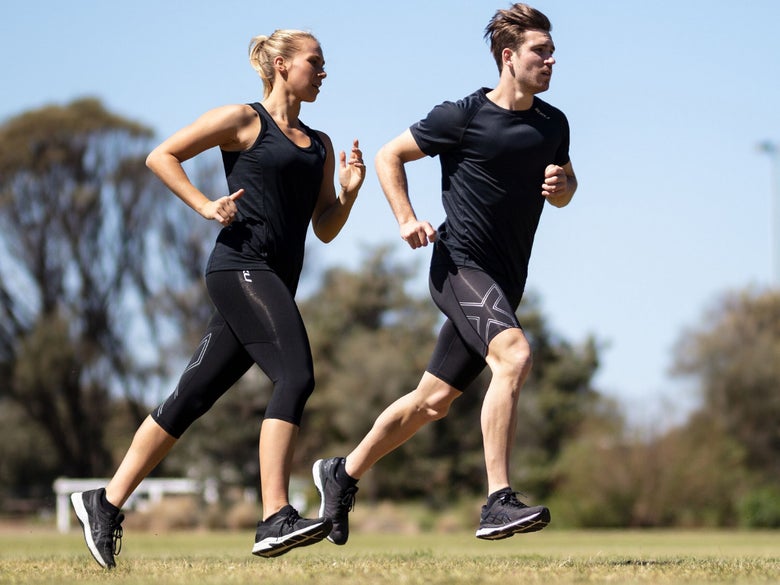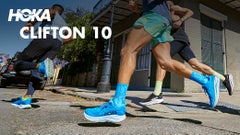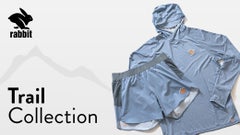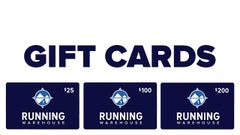How to Choose the Best Compression Socks & Clothing for Running
Updated: December 6, 2024 by Caroline Cross

You train hard and demand a lot of your muscles. Are you taking care of them in return? Compression running gear can help improve your endurance, reduce muscle soreness, and decrease your recovery time so that you’re ready for your next workout. Whether you want to optimize your performance, support recovery, or stabilize an injury, use our guide below to find the best types of compression clothing and discover the physical health benefits of wearing compression gear during or after a run.
What are Compression Clothing & Socks
Compression clothing is usually made from a combination of spandex and nylon that places firm pressure on the body. Types of compression clothing includes tights, socks, calf sleeves, arm sleeves, shorts, and tops. Originally used in the medical field to aid in the blood flow of bed-ridden patients, compression running clothing can help increase circulation and reduce recovery times. Though there is conflicting research on its efficacy when worn during activity, compression clothing is also believed to improve performance and reduce soreness by limiting muscle vibration and increasing oxygen delivery.
What Are The Different Types of Compression
1. Basic compression offers the same level of compression throughout the garment, resulting in muscle stabilization for all areas in contact with the garment. This type of compression is best for general muscle stabilization.
2. Compression for support stabilizes a specific muscle during activity. Also known as zoned or targeted compression, support compression is located directly on and/or around a specific muscle or group of muscles, thereby offering unique stability and better performance aid for the affected muscle or muscle group.
3. Graduated compression offers continuous and controlled pressure to help move blood back toward the heart. Graduated Compression is best for runners looking to maximize performance and decrease overall recovery time after a workout. In a graduated compression garment, the pressure is greatest in the area farthest from the heart, and the pressure decreases as it moves toward the heart. This gradually decreasing pressure results in improved blood flow to the heart.

Selecting Compression Gear for Running
Compression Tights: Reduce muscle vibration in the legs and promote blood circulation through these areas. Great for overall support and recovery.
Compression Shorts: Provide targeted support and reduce muscle vibrations in the hamstrings and quads while focusing on increasing blood flow through these muscles.
Compression Socks: Graduated compression socks are ideal for recovery as they prevent blood from pooling in the feet and ankles and aid in flowing blood against gravity back to the heart.
Compression Sleeves: Assist in targeted circulation as well as reduced muscle vibration.

How to Use Compression to Benefit Your Running
To find the best compression items for your needs, we suggest first identifying what you will be using it for. This will be important because there are compression garments designed for either activity or recovery while some can be used for both.
Compression for Activity
During activity, any of the three types of compression will serve a similar purpose: muscle stabilization for reduced vibration. Choosing a graduated compression item for use during activity will also increase the blood flow back to the heart. Generally speaking, if you will only use your compressive garment for activity, any compression item will suffice, and we suggest making your decision based on your specific needs. Below are some important questions to consider:
|
Compression for Recovery
While any compression garment can be worn during activity, if your primary use for the item is for recovery, choose clothing with graduated compression. Graduated compression increases blood flow which results in faster clearing of harmful byproducts produced by the body during exercise. Additionally, muscles and tissues damaged by exercise can repair themselves much more quickly when greater blood flow is supplied. These factors typically result in reduced soreness and faster recovery time.
When choosing a graduated compression item for recovery, make sure you choose clothing with compression starting at the feet. This will help keep blood moving through the legs and feet during rest. These types of compression garments are also ideal for traveling because they reduce the chance of an embolism or blood clot.

Benefits of Compression Gear
Whether you wear them for running or for post-run recovery, here are some vital physical health benefits of using compression gear:
1. Increased Blood Flow - Compression apparel puts consistent pressure on the muscles, which allows the arterial walls to relax. When the arterial walls relax, the diameter of the arteries increases, and more oxygen-rich blood can flow to the muscles. This increased oxygen flow speeds recovery time, so you are ready for your next training session sooner. The improved blood circulation can also aid in reducing inflammation by ensuring sufficient oxygen delivery to your muscles.
2. Vein Support - The veins use a system of one-way valves to carry blood back to the heart to be re-oxygenated. When a runner is stationary for a long period of time, blood can begin to pool in the feet and ankles. To reduce the swelling and pooling of fluid, graduated compression socks (which are most compressive at the extremities and gradually become less compressive as they get closer to the heart) help move this blood back to the heart to be re-oxygenated and circulated back to the muscles.
3. Muscle Support - When muscles are engaged in an activity like running, they vibrate as they absorb impact. Minimizing these vibrations can help the muscles to recover more quickly. Compression gear like graduated compression socks can help reduce muscle vibrations from ground impact by providing targeted support to specific muscle groups, so you’re ready to get back on the roads or trails with less muscle soreness. In return, your legs won't feel as tired or heavy even after a long run or a hard workout. Additionally, the added support from compression fabric can help keep inflammation and swelling at bay for faster recovery and improve overall running performance.
4. Injury Prevention - Since compression gear provides support to the muscles, tendons, and ligaments, in return it helps reduce the risk of common running injuries such as strains and sprains. Wearing compression gear can deliver stability to the muscles and joints, minimizing the risk of injury.
Check out the Compression Gear for Men and Women that we carry at Running Warehouse to find the right products to aid in your running performance and help you recover and stay fresh.








